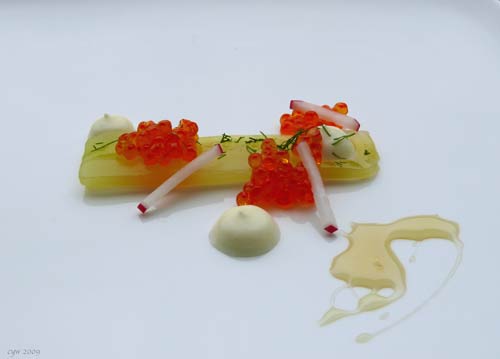Posted by Mindy Nguyen
On Monday, Nils participated in the Experimental Cuisine Collective’s symposium, “From Science to Sensation,” discussing how and where science and food intersect. If you’re following us here on the blog or have had the pleasure to dine on a dish that Nils has prepared, then you no doubt have an appreciation for not just the innovation behind each of his creations, but also for the design of his platings. In his hourlong presentation, “An Interdisciplinary Approach to Technology, Design, and Food,” Nils shed light on how science and technology have inspired him to constantly challenge himself to be innovative with flavors, textures, and aesthetics.
Transglutaminase (aka “meat glue”), hydrocolloids, immersion circulators, vacuums, etc. have all allowed Nils to take classic flavor combinations and improve upon them. These technologies have not only enhanced how food tastes, but how it feels and how it looks as well. Yes, the use of the products has revolutionized the outcome of food, but Nils stressed that it has also changed the way he thinks about food in general. Once you can challenge one formerly long-held notion of what you can and can’t do with food, then you can begin to think about what other “rules” you can break. Nils used dishes and cocktails that he has prepared for his ongoing collaboration with the Philip Johnson Glass House Conversations salon series to demonstrate some of his favorite food technology applications.

Take for example a classic Russian dish: pickled cucumbers, smetana, and trout roe. Instead of traditional pickle, why not try and preserve the crunch and freshness of the cucumber flavor while also enhancing it with all the best flavors of a pickle? He flash-pickled cucumber planks in the vacuum, allowing the natural sweetness of the cucumber to partner with the tangy flavors of the pickling liquid. An added benefit is that instead of a yellowish, graying pickle, you end up with a translucent, spring-green cucumber plank that looks almost like a molded gel. For the trout roe, Nils returned to a rule that he had broken long ago—he marinated it in yuzu and soy sauce. When he first had the idea to marinate roe with citrus, everyone said that it couldn’t be done, that the citrus have the same impact as it does on fish, essentially “cooking” it. Instead of just accepting conventional wisdom, he decided to try for himself to see the outcome. It turned out that the yuzu and soy seeped into and infused the roe while also firming the roe membrane. The stained-glass cucumber topped with vivid marinated trout roe combine with the homemade smetana beautifully, both palate-wise and visually.
Another example that Nils not only spoke about, but allowed the audience to sample for themselves, was the impact of clarification. He and Dave are obsessed with clarification, partially because of their love of carbonation, which benefits from an absence of debris—think about a pulpy mimosa and how you get that unpleasant, foamy layer at the top. And of course, crystal clear liquids are usually a little more pleasing to the eye. Nils and Dave use a number of new technologies to clarify different liquids: gelatin-clarification, enzyme-clarification, rotovap distillation, etc. Everyone in the audience was allowed to experience an FCI house-favorite for themselves: Gin n’ Juice. It’s a little different than the Snoop Dogg version. Nils and Dave clarify grapefruit juice using gelatin, and then combine the crystal clear juice with gin and a little simple syrup before self-carbonating the beverage. It’s almost hard to place the grapefruit flavor in this cocktail because there’s no bitterness. The clarification process not only results in a clean, sparkling appearance, but it also helps to highlight flavors from the grapefruit that might otherwise be masked by its characteristic bitter notes.
Nils was passionate about encouraging the audience to see technology as a way to unlock doors to culinary innovation. He encouraged chefs, scientists, and students in the room to not only think about how to improve the flavors they already understand using new technologies, but to also use modern thinking to find alternative methods of using old technologies. He ended his discussion by highlighting this blog as a way for him and Dave to share their ideas and discoveries with the food and science community. Nils and Dave are extremely proud of their roles as teachers at The French Culinary Institute, and they hope to not only give their own students the benefit of their experience, but to also be a resource for all chefs and the industry as a whole.

thanks
What is enzyme clarification? Under what circumstances and how would one use it?
Good question, Chad. Please see our post today on enzyme clarification. Thanks for the interest. Come in and skål sometime!
Thanks for the answer and the informative post. Can I skoal when we’re up in NY for Star Chefs Congress this year? You should set up a booth there and photo every chef in attendance.
Hi Chad – we’ll definitely get a shot of you skoaling at Star Chefs this year. Thanks!